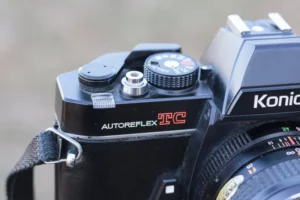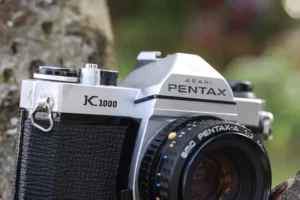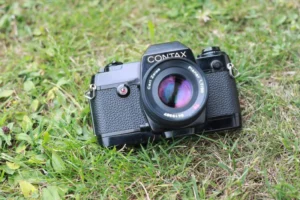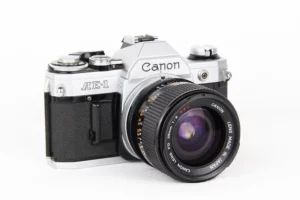Olympus OM-2n Review: How it revolutionized the camera business
Last Updated on January 28, 2023
The Olympus OM-2n is one of the most sophisticated cameras launched by Olympus in 1979, in this article we will see its characteristics and contributions to photography in terms of functionality and design.
In 1936, Olympus brought out its first camera, the Semi-Olympus I. But it wasn’t until 1959 that Olympus really entered the big stage of photography. This SLR system should keep up with the big camera manufacturers of the time like Pentax or Nikon.
Table of Contents
OM-2n Specs
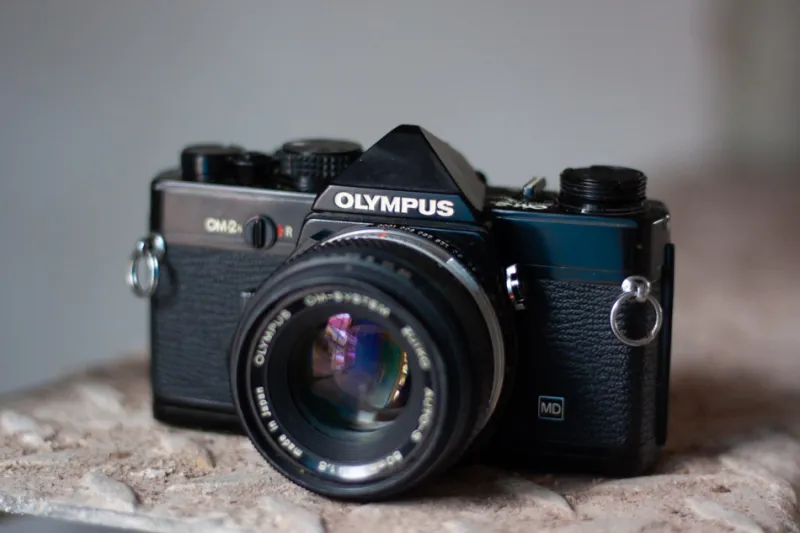
| Camera type | 35mm SLR with TTL exposure metering (open aperture metering) |
| Film format | 35mm 35mm 24×36mm |
| Shutter | horizontally fabric slot shutter |
| Exposure control | manual or aperture priority (aperture priority) |
| Exposure Compensation | + / – 2 f-stops in third increments |
| Shutter speeds | 1s – 1/1000s + Bulb, mechanically and electronically controlled |
| Self-timer | 4-12s lead time |
| Viewfinder | Pentaprism finder with full ground glass, sectional image range finder and microprism ring (exchangeable) |
| Viewfinder size | 0.92x magnification with 50mm lens, 97% coverage |
| Viewfinder information | Exposure balance with measuring needle in M mode, measuring needle for displaying the exposure time in automatic mode |
| Lens mount | OM bayonet |
| Film transport | Rapid winding lever, switching angle 150° |
| Flash control | manual and TTL |
| Accessory shoe | detachable hotshoe (usually type 4) |
| Film rewind | fold-out rewind crank |
| Flash sync | 1/60s via Hotshoe, FP or X-cable connection (switchable) |
| Exposure metering | center-weighted integral metering at film level at full aperture |
| Measuring range | LW 2 – 17 at ASA 100 and f/1.4 |
| Film speed | 12 – 1600 ASA |
| Power supply | 2x LR44 or SR44 batteries |
| Dimension (L x W x H) | 136mm x 50mm x 83mm |
| Weight | 510g |
Without Leica no OM series

Although there was already an Olympus SLR camera called FTL in 1971, it was supplied to Olympus by a third-party manufacturer and only released under their name.
A year later, in 1972, the M-1 came onto the market. The name stood for “Maitani-1”. A certain manufacturer from Germany, known for the red dot, who also had a camera with the name M1 in their portfolio, was then able to legally enforce that the name M1 could only be used by them, i.e. Leica.
So Olympus decided to sell the camera under the OM-1 label from 1973. One of the most successful camera systems, the OM system, was born.
From 1975, the fully mechanical OM-1 was joined by an electronically controlled sister camera. She got the name OM-2. From 1979 both cameras came with the suffix “n” on the market.
Differences from OM-2
The most important difference between the OM-2 and OM-2n today is that the OM-2n can use two LR44 or SR44 button cells. The OM-1n, on the other hand, continues to use the no longer available mercury button cells.
The ability to take long-term recordings has been improved. Because the longest exposure time has been doubled from 60 seconds to 120 seconds. In addition, the displays in the viewfinder have been expanded. A dedicated flash-ready indicator has been added, as well as a warning signal when exposure compensation is active.
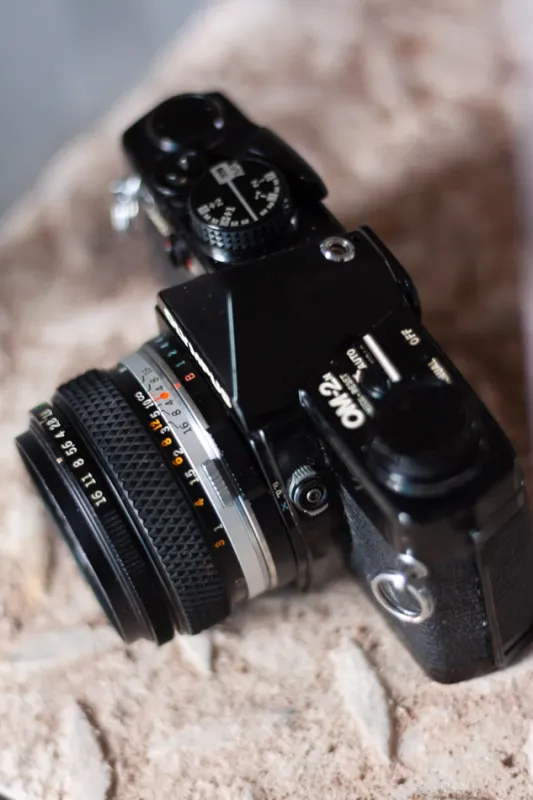
OM-2n – The compact SLR
The fact that the Olympus OM series is not just another camera series from some manufacturer, but that the understanding of what a modern camera should look like has changed so much since its introduction is probably its greatest merit. If you look at the camera, you wonder why other, better known and much larger manufacturers didn’t come up with the idea.
Because a product that is carried around all day should ideally not be too big and heavy. Maitani and his team at Olympus focused on precisely this problem. If you place Maitani’s cameras next to models from other manufacturers from the same period, you will immediately see how small the Olympus OM series is.
With the OM-1, the end of the large, heavy photo cameras was sealed. From now on every manufacturer wanted to offer small, handy cameras in the style of the OM series.
From this one could conclude that the compactness of the cameras inevitably entails doing without equipment, but that is wrong thinking. Because both the inner and outer values of the Olympus OM-2n are absolutely right.
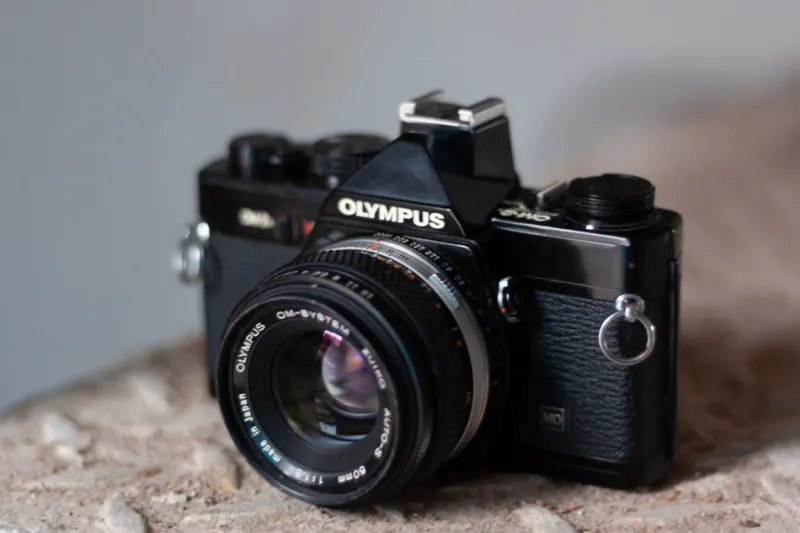
Small on the outside, big on the inside
In contrast to today, where small cameras only have small viewfinders, the OM-2n can come up with a huge one. A magnification of 0.92 at 97% coverage is unparalleled. And that’s worth emphasizing again when you see how small the prism hill on the camera really is.
But not only the compact design is a unique selling point of the Olympus cameras of the OM series, but also the decision that the shutter speed is not set with a rotary knob on the top of the housing, as with other manufacturers, but on a ring on the bayonet of the housing . This design decision seems strange at first, but the shutter speed can be ideally adjusted in everyday life. In addition, it creates space on the top of the housing.
The space gained on the top of the housing is also needed. Because on the left we find the usual rewind wheel, as usual at the time, made entirely of metal.
Between the rewind wheel and the prism hill is the switching lever, with which you can turn the camera on and off. This has four positions, on the one hand the “off” position, to the left of it the position for manual operation, above it the position for automatic operation and finally you can push the lever all the way up. This position activates the battery test light or performs a reset as a secondary function.
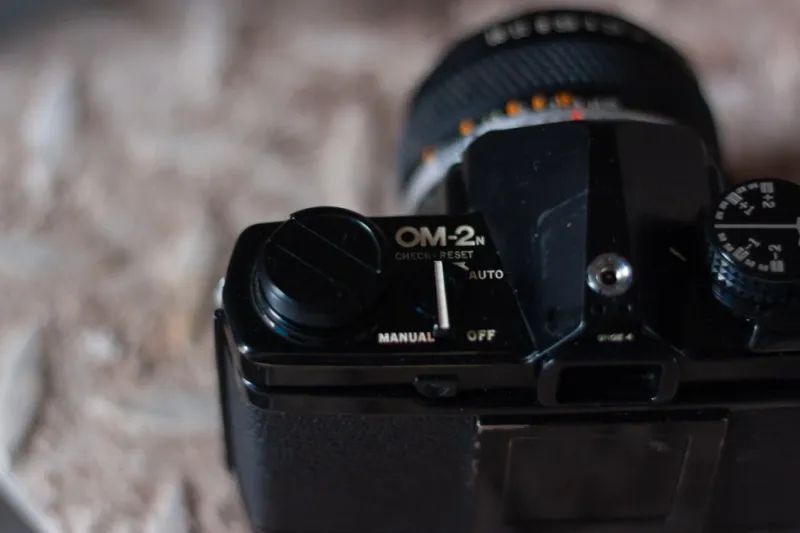
Controls of the Om-2n
On the right shoulder is a dial on the left, next to it the shutter release button and on the right the film winding lever. The dial has two functions.
On the one hand, it serves as an exposure correction. On the other hand, it serves as a setting for the film sensitivity. The OM-2n can be adjusted from 16 ASA to 1600 ASA.
To adjust the film speed, the knob must be lifted and then turned.
The exposure compensation can already be adjusted from +2 to -2 in steps of three. If you adjust the exposure compensation, a small ± appears in the viewfinder as a reminder that the knob was turned. This is very helpful so that the exposure has not been changed unfavorably by mistake.
The release button has a very nice pressure point and also has a mount for a cable release.
The film winding lever has a very pleasant shape. Despite the fact that it is made of plastic, it is very nice to touch. You can fold it in completely or fold it down a bit in order to advance the film faster.
On the outer edge of the right shoulder is a small window with the frame counter. It is clearly labeled with silver numerals, with the 20, 24 and 36 being gold to set them apart. The counter begins with an S for start and finally ends with an E for end.
There is a detachable hotshoe on the Prisma cover. With this hotshoe and the associated flash, it is possible to realize a TTL flash exposure metering with the OM-2n.
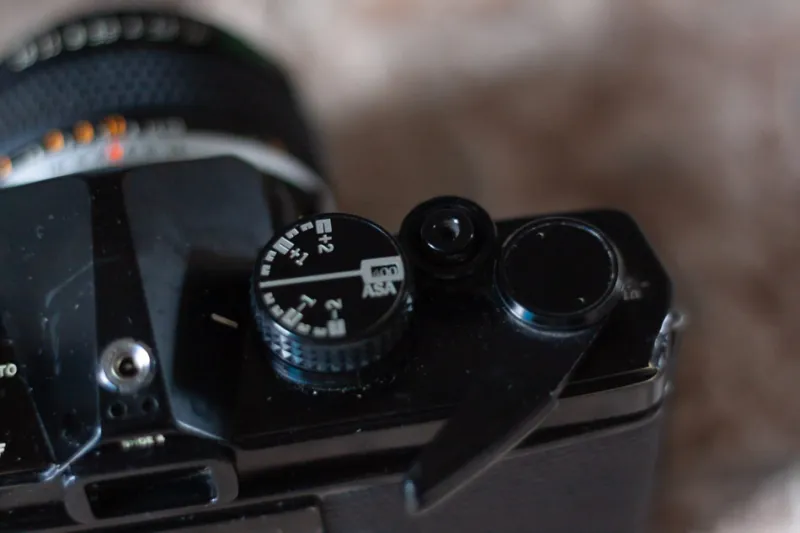
The unusual front
On the front we find more controls. Seen from the front on the right side of the lens bayonet there is an external flash connection with FP or X contact. This can be switched so that two separate connections are not required, as is the case with other cameras.
There is also a B-Lock button on the bottom that you have to press if you want to activate Bulb mode.
Olympus implements another technical solution for the lens mount, which is rather unusual for SLR cameras. Because that’s where the dial for the exposure time is located.
The lens is, so to speak, attached to this time dial and the time is adjusted as well as the aperture and focus on the lens barrel. Contrary to custom, all relevant settings are made on the lens or the lens mount. Of course, this only applies if you don’t use exposure compensation.
The OM-2n does not have a dimming lever, as this is already built into the lenses. On the left side, seen from the front, is the release for rewinding the film, by the way probably the most beautiful of all classic cameras. Underneath is the lever for the self-timer. This can be continuously adjusted between 4 and 12 seconds.
Other notable elements of the camera include a small battery test LED on the back. There is also a label holder that is filled from below on the OM-2n.
On the underside we find the battery compartment, a tripod thread, the serial number and the note “Made in Japan“.
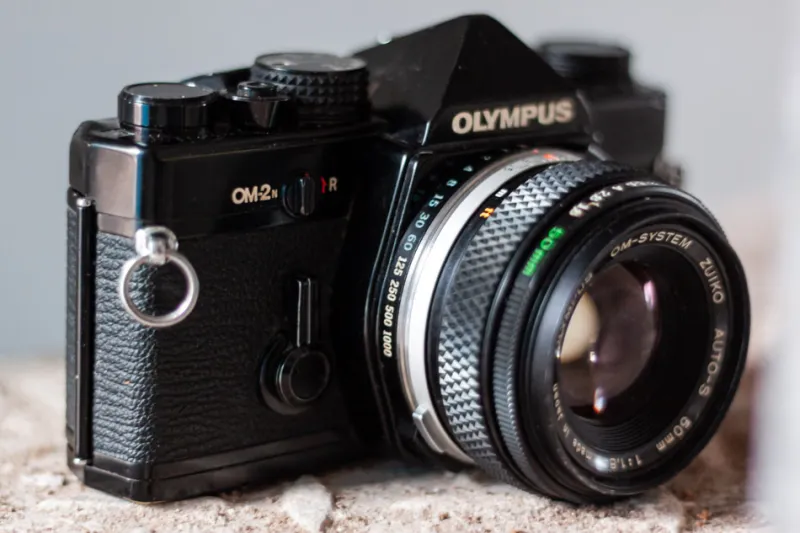
A mad seeker
Taking photos with the Olympus OM-2n is a lot of fun. An important reason for this is the very large and very tidy viewfinder.
The interchangeable screen offers the usual microprism ring plus sectional image indicator in the middle.
On the left edge there is an exposure scale in manual mode, which only shows a plus and a minus with two arrows pointing up and down.
If the needle is in the middle, the exposure is correct. If the needle is just before the up arrow or just before the down arrow, the exposure is set exactly half an aperture too high or too low.
On the arrow it is one stop, on the + or – the exposure deviates by 2 stops. This helps when taking photos and the desired aperture/time combination can be found quickly even in difficult lighting situations.
Unfortunately, the exposure time or the aperture used is not displayed in the viewfinder. There would have been enough space and it would make the viewfinder one of the best on the market.
I wonder why such viewfinders aren’t made anymore these days. You can buy cameras with all sorts of bells and whistles, but none offer a viewfinder nearly as large as the analogue models of the 70’s and 80’s.
Sometimes the reduction to the essentials would have a few advantages.
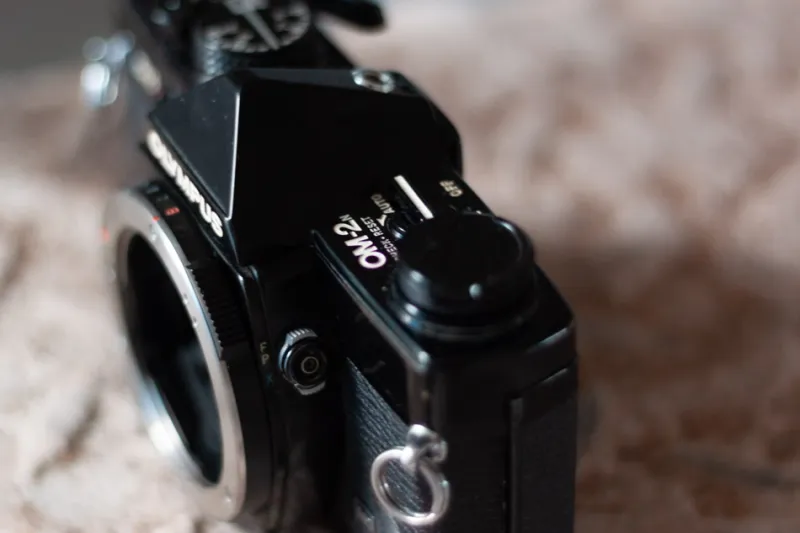
Revolutionary exposure metering
Another highlight of the Olympus OM-2n is the exposure metering.
The OM-2 already had an aperture priority, in which the exposure was measured dynamically at longer shutter speeds.
This means that the exposure time could be adjusted during the exposure. This also means that the OM-2, as well as the OM-2n, could offer film-level TTL flash metering.
The OM-2 was the first SLR with this feature. A Minolta patent allowed Olympus engineers to add multiple measurement cells to the camera bottom and viewfinder to perform this very advanced measurement.
This patent not only helped with TTL flash metering, but also with long exposures. Because from about 1/15 of a second or slower, this method was used. First, the camera measured the brightness of the subject to have an indication of how long the exposure time is.
The time measured in this way is also the information that is displayed in the viewfinder. When the shutter button is pressed, the previously displayed exposure time is changed during the recording so that the correct exposure took place.
Of course, all of this is very grateful when the lighting conditions change a bit during the shot, especially with long exposures.
With the shorter exposure times, the Olympus OM-2n used a computer-generated average image from around 10,000 individual images in order to measure the light as accurately as possible.

Conclusion
“Small, but mighty!” That’s the first thing I think of when I get my hands on the Olympus OM series. In the mid-1970s, Olympus catapulted itself to the top of the world camera manufacturers with its small cameras.
The OM-2n is packed with highlights that make it a pleasure to use. The small dimensions, which do not represent a compromise, but absolute progress in camera construction.
The great manufacturing quality paired with technical innovations such as dynamic exposure metering or TTL flash exposure metering.
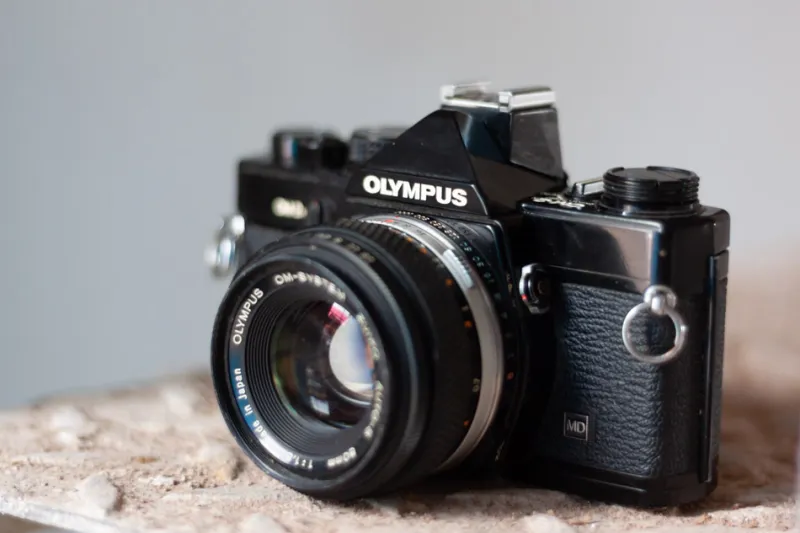
In terms of price, there are well-preserved models for under $US 150. It may not quite have the reputation of a Pentax K-1000, but overall it is the better camera.
In my opinion it is worth every penny. Especially photographers who prefer classic cameras with aperture priority or someone who depends on accurate flash metering should take a closer look at an OM-2n.
A camera that lives up to its lofty name. If photos are to be taken on the mountain of the gods, there would be no shame if the camera involved was an OM-2n.
Yoshihisa Maitani, who died in 2009, has at least brought himself to the Olympus of camera designers with the OM series. Let’s hope he still has as much fun with his creations today as he did back then.

